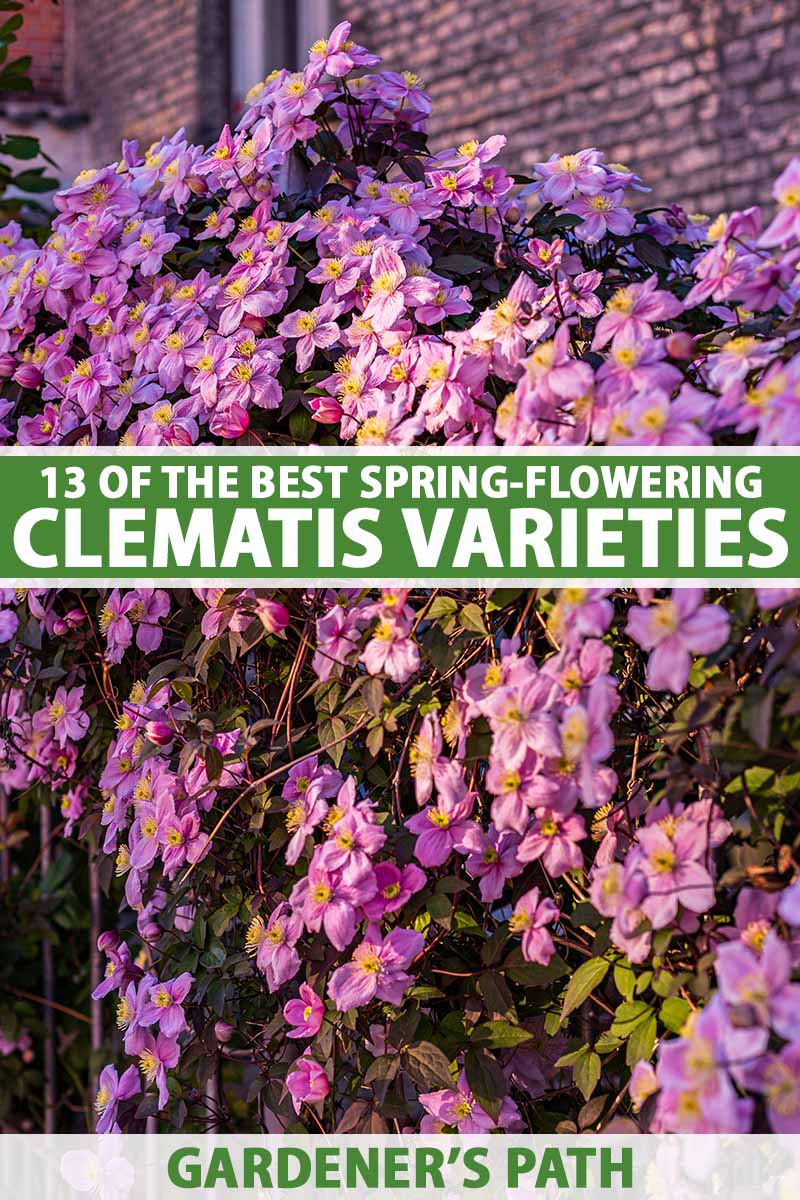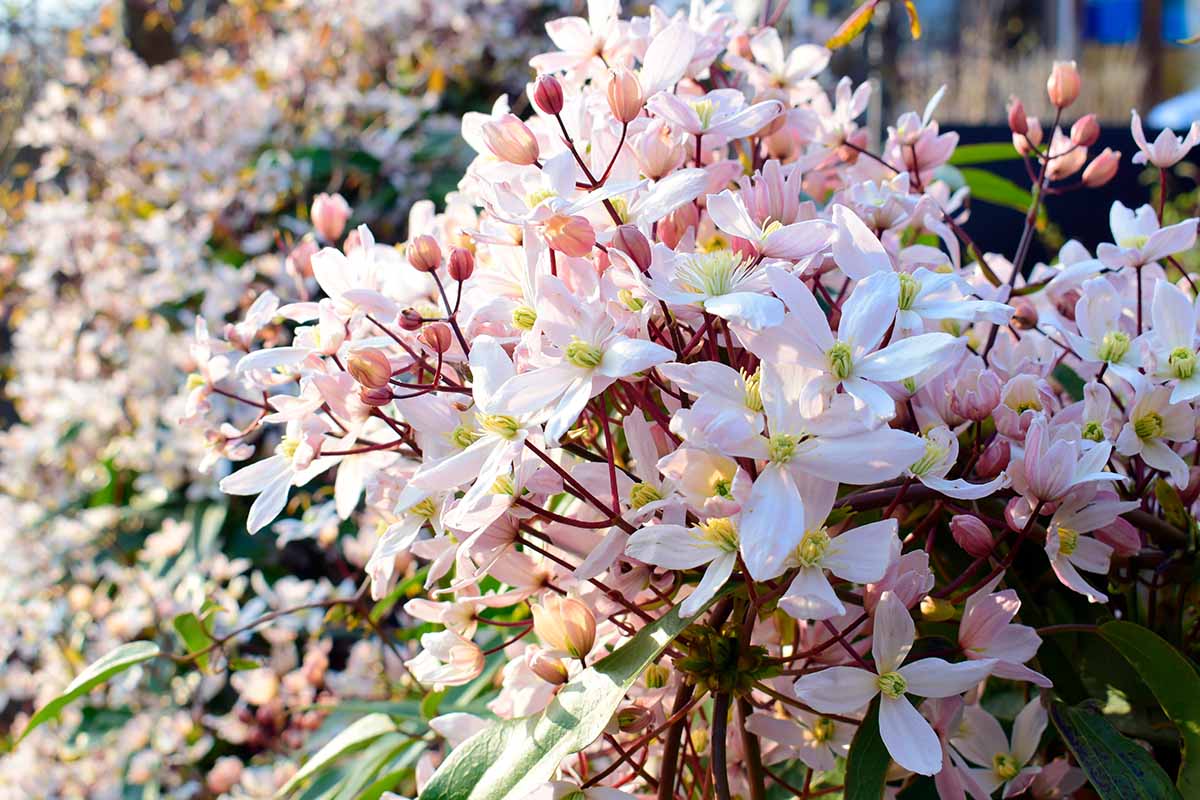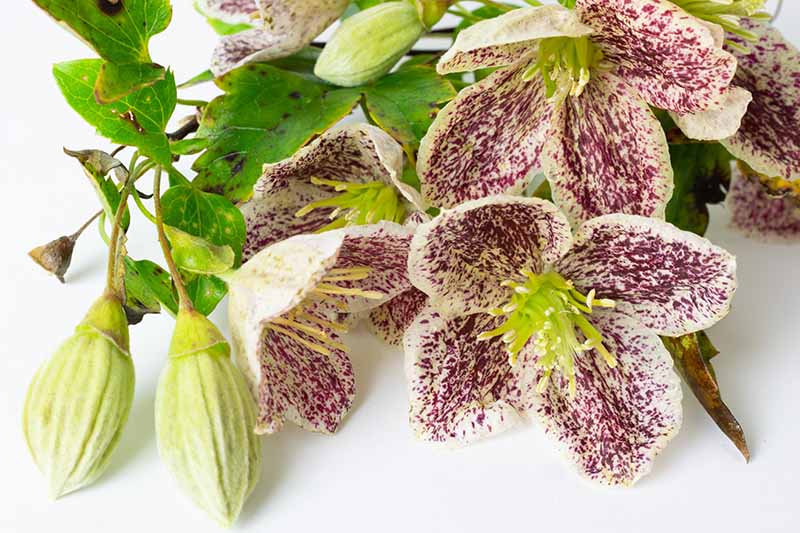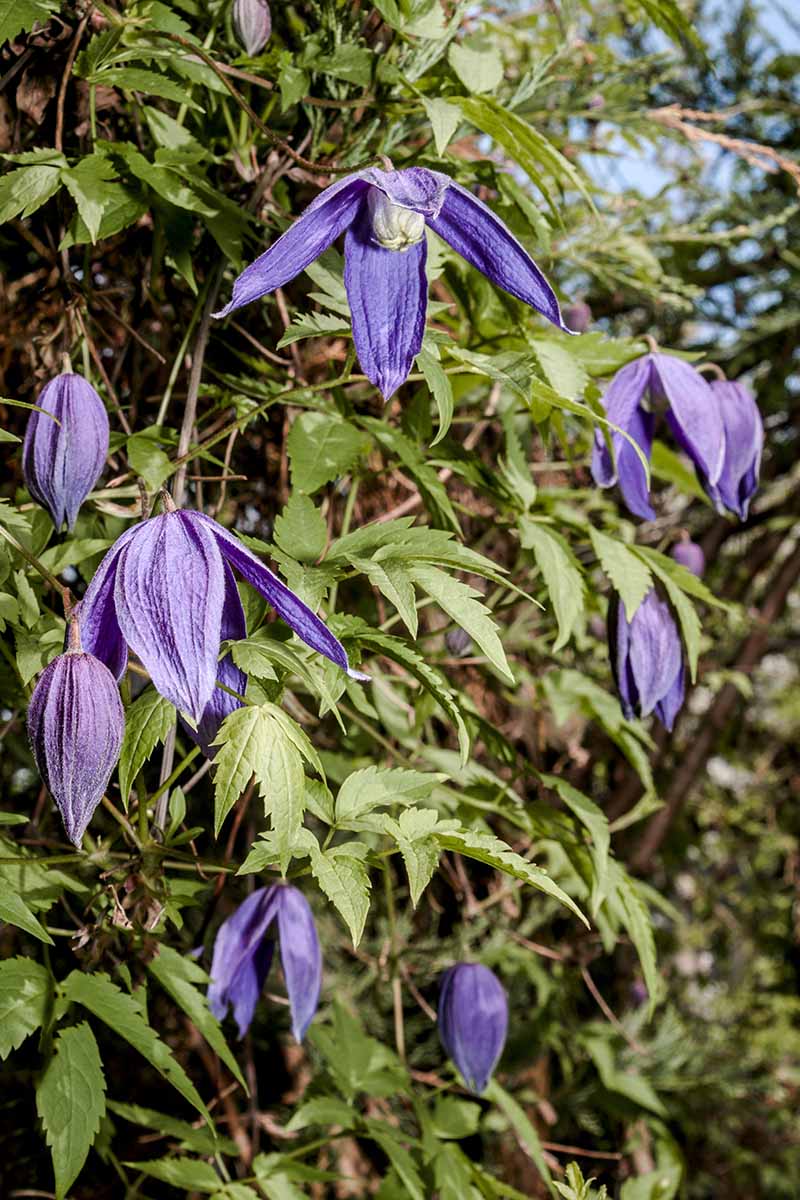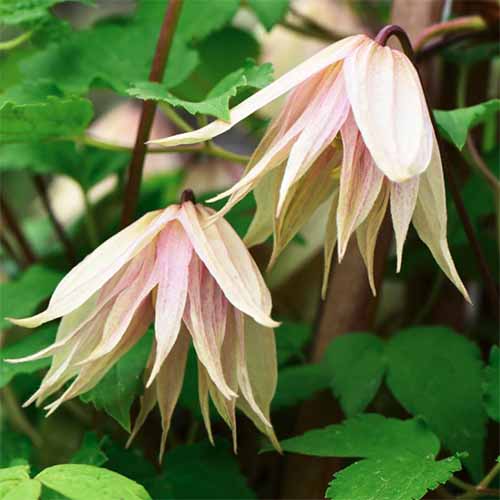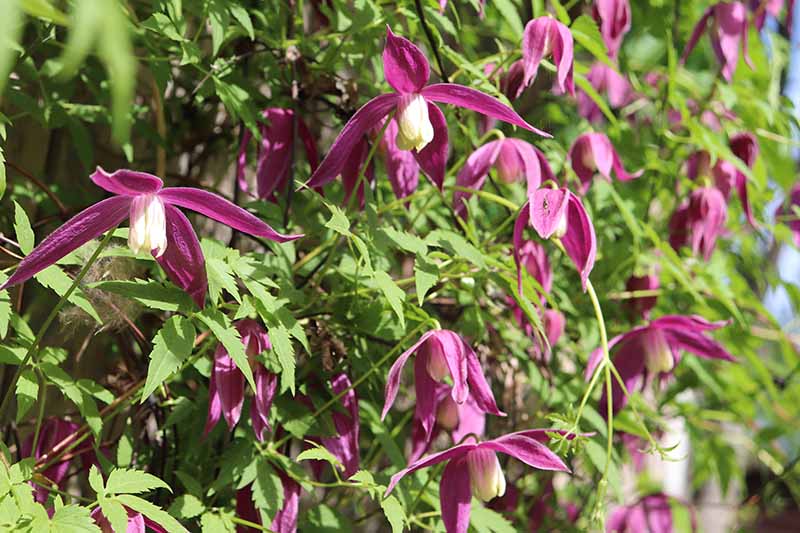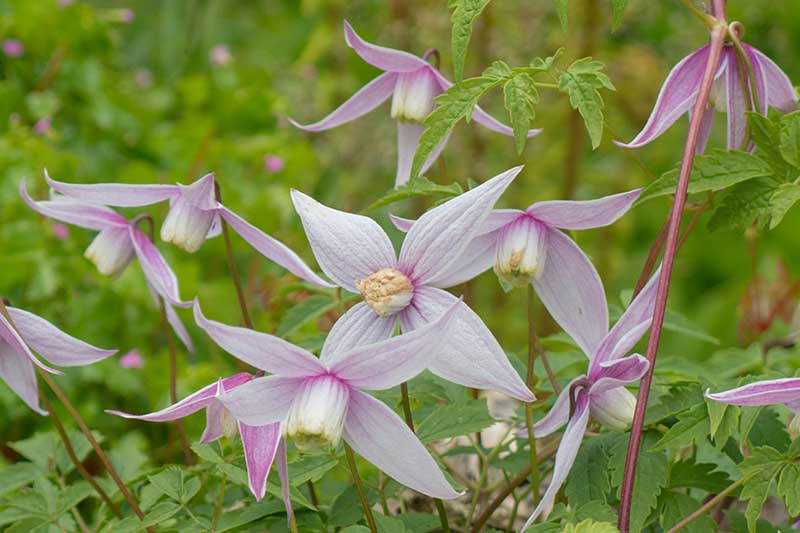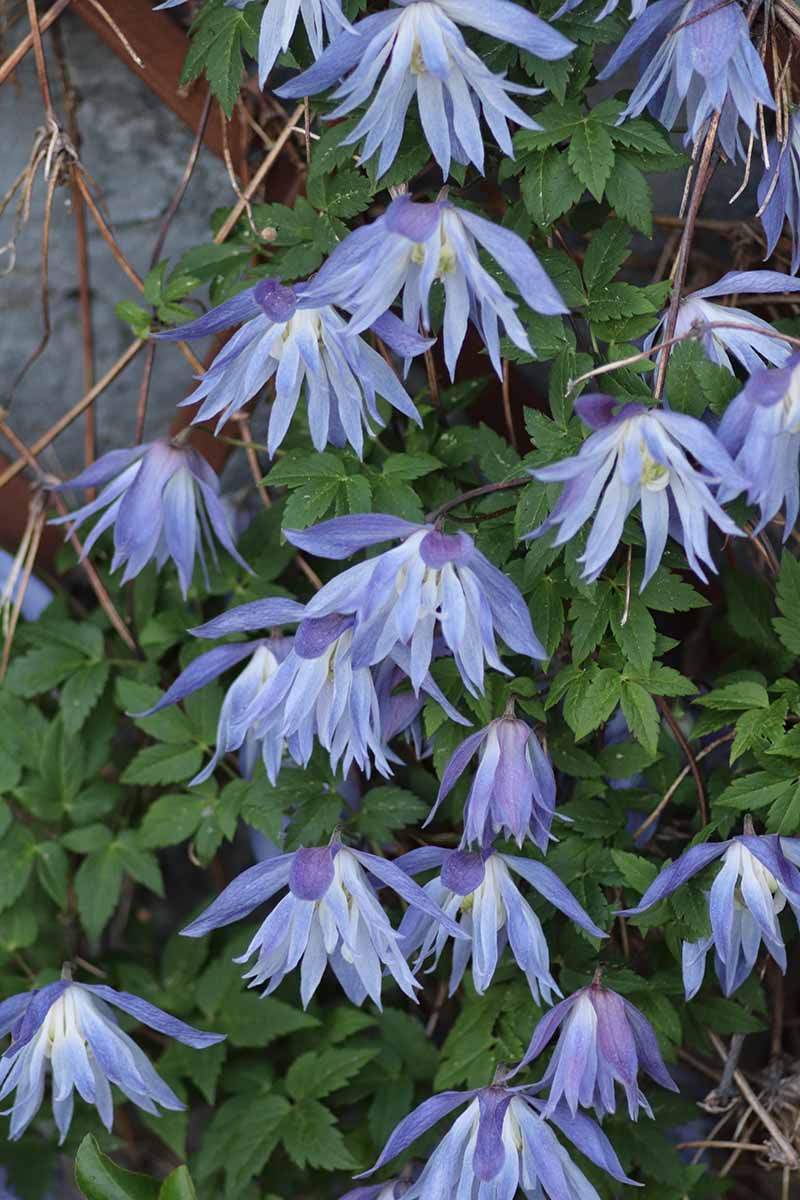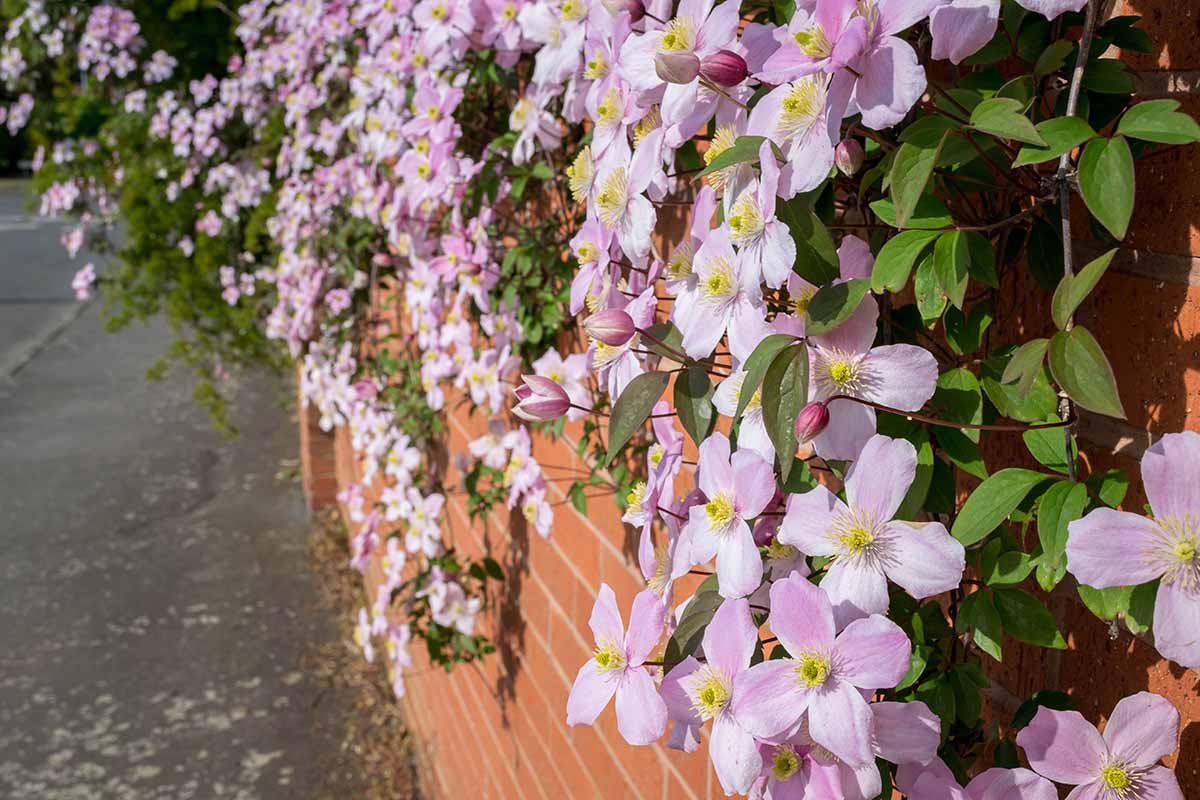This group includes several species and hybrids, with some that bloom as early as December and continue until mid- to late spring, depending on your region. Evergreen varieties require mild winters, but most are deciduous with good cold hardiness. Varieties include the very early evergreens like ‘Apple Blossom,’ alpine cultivars such as ‘Pamela Jackman,’ the nodding macropetala varieties like ‘Markham’s Pink,’ incredibly floriferous montanas such as ‘Rubens,’ and the scrambling, rockery varieties like ‘Avalanche.’ Many have showy, silky seedheads that add ornamental interest in fall and winter, and several provide sweet perfume as well. Clematis armandii and C. montana. are highly fragrant. We link to vendors to help you find relevant products. If you buy from one of our links, we may earn a commission. Another benefit of these early bloomers is that Group 1 vines require no pruning. Annual care and maintenance is super easy – a simple, light cleanup of broken, dead, or unwieldy stems in late winter or early spring is all they need. Flower sizes are smaller than those of the flashy summer varieties, measuring one to four inches across. And the colors are more limited too, mostly available in variations of blue, pink, purple, and white. But for tough, easy-care plants that give reliable – and sometimes spectacular – floral displays early in the year, Group 1 clematis plants are your go-to vines. Beautiful, easily cultivated, and low maintenance, they’re perfect additions to the garden! Here’s our lineup for 13 of the best spring-flowering clematis:
1. Apple Blossom
Sweet as pie, C. armandii ‘Apple Blossom’ is laden with masses of pale pink, almond-scented blossoms that bloom from late winter to mid-spring. The small, pretty buds are a deep ruby color that open to pink, and petals (technically, they’re sepals) fade to white as they age. The small, open-faced flowers measure one to two inches. They have four to eight plump petals, and lacy, gold stamens. An evergreen variety, the ovate foliage is dark green and glossy, and makes a handsome year-round screen. A robust climber, ‘Apple Blossom’ is vigorous and fast-growing, reaching a length of 20 to 40 feet. An excellent choice to frame doors, porches, and windows, espaliered as a screen, or trained along fences, pergolas, and walls, this cultivar is hardy in Zones 7 to 11.
2. Avalanche
Another evergreen, ‘Avalanche’ (aka C. x cartmanii ‘Blaaval’) produces cascades of sweet and dainty white blossoms that bloom in early spring. The six-petaled, daisy-like blooms measure two to three inches and feature gold to platinum stamens. The dark green, leathery foliage is ternate (meaning three-part) and deeply lobed, making an attractive four-season screen. This is a gorgeous choice to train on fences, trellises, and walls, or use it as a ground cover to clamber down banks or up and over retaining walls and stumps. The vines grow moderately fast to a length of 12 to feet 15, and are hardy in Zones 7 to 9.
3. Blue Bird
Happiness abounds when you see C. macropetala ‘Blue Bird’ put on its delightful display of nodding, single- or semi-double flowers in early spring. The blooms have lightly twisted petals in vibrant periwinkle blue with cream-to-chartreuse stamens. And the vines occasionally rebloom in midsummer. A deciduous, multi-stemmed variety, the serrated, ternate leaves are bright green, and showy silver seed heads adorn the vines in summer and fall. An excellent twiner to espalier on fences, you can also train it to grow up trellises and walls, or let it scramble over arches and frames. Growing quickly to a height of eight to 10 feet, ‘Blue Bird’ is one of the hardiest varieties in extreme cold temperatures, and it thrives in Zones 2 to 9. This cultivar is also tolerant of light shade.
4. Freckles
Budding from winter to late spring, C. cirrhosa var. purpurascens ‘Freckles’ features adorable, cup-shaped blooms of pale pink that are heavily freckled in magenta. The lightly fragrant, open flowers have dainty gold stamens and measure one to two inches. A good climber for arches and trellises, ‘Freckles’ also suits rambling through mixed beds and borders, or spilling from large containers. An evergreen, the leaves are dark green and glossy, and make an attractive four-season screen with showy silver seed heads in summer and fall. These plants grow six to eight feet, and are hardy in Zones 7 to 9.
5. Maidwell Hall
Beloved for its abundant showing of fantastically frilled, semi-double flowers in lavender blue, C. macropetala ‘Maidwell Hall’ blooms face down and outward, with gold-to-chartreuse stamens. The multiple petals are slightly twisted on two- to three-inch blooms that open in early to mid-spring, with a light rebloom in summer. Ornate, swirling seed heads pepper the vines in summer and fall. The deciduous foliage is dense and full on the multi-stemmed vines, which reach a mature length of six to eight feet. This variety is a good selection for containers, courtyards, and patios, or for use as a ground cover, scrambling through beds and over problem areas. Robust and hardy, ‘Maidwell Hall’ is suitable for growth in Zones 3 to 9.
7. Pamela Jackman
C. alpina ‘Pamela Jackman’ produces an abundant display of pretty, pod-like buds that open to reveal frilly, nodding blooms in mid- to late spring. Blooming a bit later than some of the others in this group, in late spring to early summer, the small, open-faced flowers measure two to three inches. The vines are fast-growing to a length of 30 feet. The deciduous, trifoliate leaves are medium-green with a distinct bronze cast to the edges, and burgundy tones in fall. ‘Mayleen’ Spectacular for framing doors and windows or climbing on fences, latticework, pergolas, and walls, ‘Mayleen’ has good resistance to clematis wilt and is hardy in Zones 6 to 9. ‘Mayleen’ plants are available at Nature Hills Nursery. The two-inch flowers have purply-blue outer petals and a white inner skirt with chartreuse to yellow stamens. These morph into lovely, silver seed heads for summer and fall. ‘Pamela Jackman’ is gorgeous on fences, pergolas, and walls, and adds unique interest when trained against conifer hedges. The deciduous, multi-stemmed vines grow up to 12 feet in length, and are hardy in Zones 4 to 9.
9. Pixie
Bewitching as the wee folk, C. cartmanii x ‘Pixie’ is a dwarf evergreen that produces masses of delicate, creamy white blooms with lime green stamens and a lovely, citrusy perfume. The dense vines blossom in mid-spring with an occasional, light rebloom in summer. The nodding, four-inch flowers have pale pink outer petals and lightly twisted, creamy inner ones that swing open and flare out like a tutu. ‘Pink Swing’ Deciduous and multi-stemmed, ‘Pink Swing’ adds breezy charm when trained along fences, over stumps, and up and through shrubs like rhododendrons, or it may be used as a ground cover. These plants grow six to 11 feet, and are hardy in Zones 4 to 9. Bare root plants are available at Home Depot. The small, eight-petaled single flowers are open-faced, and bloom in early to late spring. The compact vines grow up to five feet in length, and with a prostrate growth habit, they’re ideal for spilling out of large containers or window boxes, scrambling through rockeries, or climbing up a small obelisk. ‘Pixie’ appreciates a sheltered growing site, and is hardy in Zones 7 to 9.
11. Ruby
A bright gem in the early spring garden, C. alpina ‘Ruby’ features nodding and boldly colored, pinky-red flowers with pale yellow stamens that occasionally rebloom on new wood in summer. The two- to three-inch buttercup-like blossoms cover the vines and exude a sweet vanilla fragrance. Fluffy silver seed heads follow. A deciduous variety, the small, ternate leaves have a handsome bronzed-green hue and take on burgundy tones in fall. Rubens The vigorous vines need sturdy support for proper growth, and are stunning when climbing porches, framing doors and windows, or winding through large trees. Rubens has good resistance to clematis wilt and is hardy in Zones 6 to 9. Plants are available at Nature Hills Nursery. With a trailing, scrambling habit that works well as a ground cover, ‘Ruby’ is also a good climber on trellises, and makes a pretty choice for containers, courtyard gardens, and patios. The deciduous, multi-stemmed vines are fast-growing with a mature size of five to 10 feet. These plants are hardy in Zones 4 to 9.
12. White Swan
Serene and graceful, C. macropetala ‘White Swan’ features a bevy of snow white, nodding flowers with soft, buttery yellow stamens that bloom in late spring to early summer. Wooly seed heads adorn the vines in summer and fall. The multi-stemmed, deciduous vines have a twining and trailing habit that’s well-suited for use as seasonal hedges and screens, as a scrambling ground cover, or spilling down banks and over retaining walls. ‘White Swan’ grows 10 to 12 feet, and is hardy in Zones 3 to 9.
13. Willy
Dainty and elegant, C. alpina ‘Willy’ features a handsome display of nodding, mauvy-pink flowers with buttery yellow stamens that blossom in mid- to late spring, and may rebloom lightly in summer. A multi-stemmed deciduous vine, the three- to four-inch blooms are followed by fluffy silver seed heads in summer and fall. The vines grow six to 10 feet with a twining, trailing habit that can be trained onto obelisks and trellises, or used as a ground cover for spilling over slopes and walls. ‘Willy’ is hardy in Zones 3 to 9.
Tips for Growing Group 1 Vines
Easy and highly rewarding to cultivate, there are only three rules for growing clematis: Spring-blooming varieties are the earliest species and hybrids in the Clematis genus to flower, and these belong to Group 1, the non-pruning group. New buds form on shoots from old wood, and the plants require only a light grooming to clean and tidy them up at the end of winter. This group also has some of the largest specimens, with thick, woody stems and an extensive reach of up to 30 or 40 feet for species like C. montana and C. armandii. When planting, ensure the larger varieties have sturdy supports that can bear the weight of mature plants, particularly the evergreens, which can develop lush – and heavy – foliage canopies. Also, because they climb with small petioles, or leaf stems, clematis vines can’t entwine large structures on their own – even one-inch trellis slats can be challenging. To help new vines begin climbing, attach small-gauge netting, twine, or wire to the bases of larger structures for the petioles to grasp. Once established, vines readily grow in the direction of their support. Should mature vines need to be cut back for plant rejuvenation or home maintenance, prune hard immediately after flowering, cutting stems back to about 12 inches from the ground. You may need a saw to cut through thick, mature stems. New buds can grow from the old stems, but most new growth appears as shoots emerging from the root ball in summer or the following spring. Reduce watering but continue with a regular schedule to keep the roots lightly moist. Also, gently work in one inch of compost throughout the root zone. When new shoots are 12 to 16 inches long, water regularly and feed with a balanced 10-10-10 NPK fertilizer. For more cultivation details, check out our complete clematis growing guide. And these Group 1 vines are easy-care to the max, with no pruning required! Try the versatile, multi-stemmed varieties as shrubby, sprawling ground covers, or to add colorful appeal climbing up trellises on patios and in beds, containers, and courtyards. For the large, woody specimens, train them onto sturdy structures like arbors, pergolas, and porches for superb early displays with masses of flowers. Do you folks have any favorite early clematis cultivars? Let us know what works for you in the comments section below, and feel free to share your photos! And for more clematis know-how, add these articles to your reading list next:
19 of the Best Summer-Flowering Clematis for Your Garden27 of the Best Cold-Hardy Clematis17 of the Best Fall-Blooming Clematis VarietiesTypes of Clematis and How to Identify Your Vines
